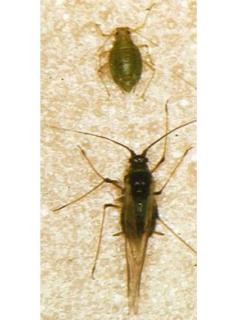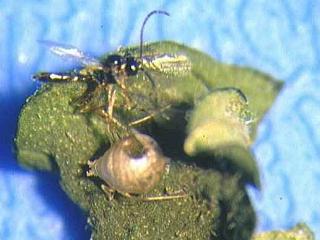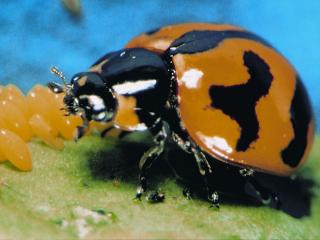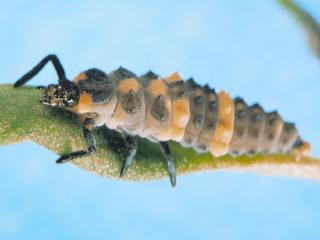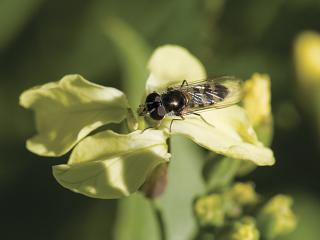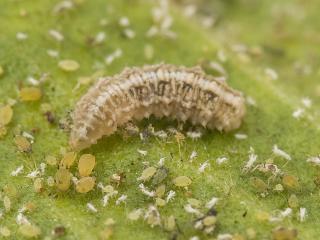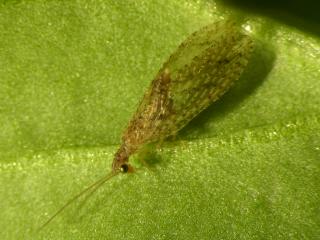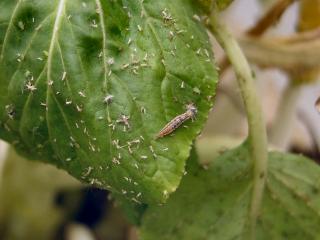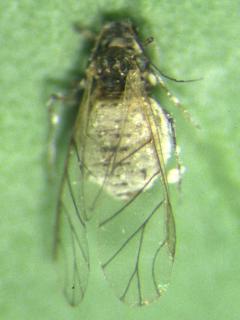Identification
Three main species of aphids attack cabbages and other brassica vegetable crops. The Indonesian name for all three species is "kutu daun" and the scientific names are Brevicoryne brassicae (cabbage aphid), Lipaphis pseudobrassicae (turnip aphid) and Myzus persicae (green peach aphid).
Cabbage and turnip aphids are the main species that attack cabbages. Green peach aphid can also attack cabbages, mainly in the early growth stages. Information on green peach aphid as a pest of potatoes is available.
The aphids are 1.5 to 2.5mm long with two tubes called cornicles on the end of the body. Use a 10x hand magnifier to be able to positively identify an insect as an aphid.
Adult aphids can be winged or wingless. Winged adults invade crops and produce live nymphs which grow to become wingless adults. When populations on leaves are high, nymphs become winged adults.
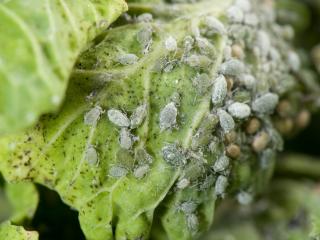
Cabbage aphids are greyish to mid-green and covered with a white wax. If they are parasitised by a wasp, their bodies become brown as the wasp larva grows inside the aphid body killing it. These aphid shells expand and are called 'mummies'. The wasp adult chews a circular hole through the aphid skin to emerge.
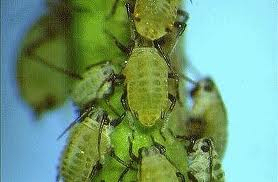
Turnip aphids are yellowish to olive green and have little or no wax covering.
Green peach aphid winged adults have black patches. Nymphs or wingless adults can be yellow or green to pale brown.
Management
Aphids feed on the underside of leaves. They suck sap causing leaves to curl, wilt or distort. Young plants have reduced vigour, are stunted, produce small heads and may be killed. When older plants are infested, they can make them unmarketable by fouling the plant.
Aphids can invade crops from emergence onwards. This is most likely to happen during changes in weather such as from summer to autumn or winter to spring. Adults are less likely to be present or invade crops in hot conditions such as mid-summer or when it is cold such as mid-winter.
Monitor crops weekly - check the underside of 100 lower leaves across the crop including the edges of the crop.
Some aphid infestation can be tolerated because the wide range of natural enemies that feed on aphids can control them. These include parasitic wasps and predators such as ladybirds, hover flies and lacewings. When humidity is high, a fungal disease attacks aphids. Check for these natural control agents during crop monitoring.
In regions where aphid presence is consistent at certain times of the year, seed dressing or seedling drenches before or at planting with systemic insecticides will protect crops during establishment.
During early crop growth, apply insecticide to the foliage if monitoring shows a high proportion of plants are infested with winged and wingless aphids.
As aphids feed on leaves only, levels up to around 25% plants infested may be tolerated. As the crop grows, if natural control agents are not present, aphids may need to be controlled to prevent them from fouling the marketable part of plants. This could be a result of the presence of aphids or both the presence of aphids and sooty mould which grows on the honey dew that aphids secrete.
Acknowledgment
Funding for this work to support Indonesian potato farmers and WA seed potato exports was provided by ACIAR (the Australian Centre for International Agricultural Research) and the Department of Primary Industries and Regional Development, Western Australia.


